Ask the Plant Expert: which flower is this?
Hi, A florist brought in these beautiful flowers into our office today. My colleague and I are trying to figure out what kind of flower it is. Could you help us identify it? Thanks! Poorvi
Everything you want to know about flowers!
Ask the Plant Expert: which flower is this?
Hi, A florist brought in these beautiful flowers into our office today. My colleague and I are trying to figure out what kind of flower it is. Could you help us identify it? Thanks! Poorvi
This month’s favorite flower color is amethyst. Starting last month, we are spotlighting unique flower colors for you to use in custom flower arrangements, wedding bouquets, centerpieces and anywhere else you might need flowers. To make the colors chosen a little more interesting, we are starting with birthstone colors. Last month’s was garnet, and this month it’s amethyst, or purple.
Amethyst is a violet variety of quartz often used in jewelry. Amethyst occurs in primary hues from a light pinkish violet to a deep purple. Amethyst may exhibit one or both secondary hues, red and blue.
When creating a color palette for your flower arrangement or wedding bouquet, choose analogous colors to amethyst, meaning next to it on the color wheel. These include dusty pinks and mauve-ish purples. Amethyst’s complement is a vibrant, bright green — a great way to make your purple flowers really POP! The tetrad and triad colors of amethyst are also easily incorporated into floral designs. The triad’s turquoise and tawny-browns give this hue a surprising rustic mood. Keep these colors in mind when creating your next Amethyst purple flower arrangement or color palette.
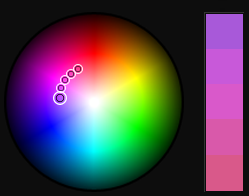
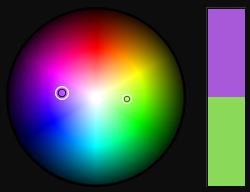
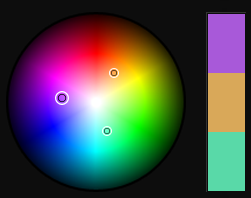
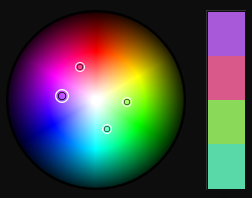
The following guide are a collection of very unique, amethyst colored flowers available from your local florists. Of course, there are also lovely purple roses, but most people know about those! This guide focuses on a purple flowers you might not think of!
This is a great flower guide for brides looking for unique color palettes and unusual flowers for their wedding. [Read more…]
Ask the Expert: Can you ID this weed?
I live in Charleston, SC and it is taking over my yard this spring. It has a purple flower.
THanks. Mac
Plant Expert Reply:
What you have is called Spring Vetch (Vicia sativa). In most places it is considered a weed. To get rid of it in your yard, you can spray 2 4 D or a Greenlight product called wipe-out. These products will kill the broadleaf weeds in your yard, but they will not harm the grass. Your local garden center and nursery in will have this product on the shelf. They will be able to tell you how to mix it and when to spray it in your area.
Caution: 2 4 d or wipe out can only be used in yards. It can not be used in shrub beds.
This weed identification question was sponsored by the local florists in Charleston SC.
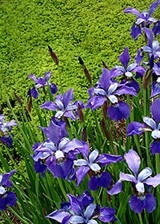 Every spring, I begin the process of taking stock in my garden. What survived the cold winter? What areas just need sprucing up or an extreme makeover? Then, I head to my favorite nursery and begin my annual indulgence—plant shopping! The color I gravitate to most is purple—from pale periwinkle to luscious lavender to deep, velvety jewel tones.
Every spring, I begin the process of taking stock in my garden. What survived the cold winter? What areas just need sprucing up or an extreme makeover? Then, I head to my favorite nursery and begin my annual indulgence—plant shopping! The color I gravitate to most is purple—from pale periwinkle to luscious lavender to deep, velvety jewel tones.
Purple adds drama and mystery to my garden. I add yellow, pink and white flowers to add contrast and lighten the palette. To create great focal points with intense color, I combine shades of orange or gold in front of a swath of purple blooms. My favorite color combination is combining a punch of chartreuse with deep purple—talk about eye candy!
Below are some of my favorite purple blooms:
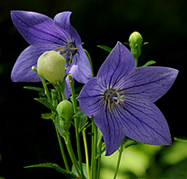 |
Balloon Flower or Chinese Bellflower (Platycodon) is a perennial plant known for its large, showy blossoms that resemble hot air balloons right before they open. The plant forms in clumps and each stem bears bell-shaped flowers in pink, purplish-blue and white. Grown in full sun or partial shade, they bloom throughout the summer. |
| Easy to grow, the striking Bearded Iris is a drought-tolerant plant with blooms in a rainbow of colors. Grown from rhizomes, these perennials blossom in spring, although there are summer-blooming irises. The blooms are large, showy and make a great backdrop in your garden. | 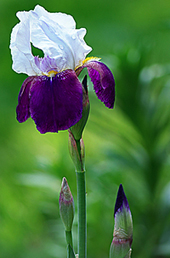 |
|
|
Harbingers of spring, Crocus are one of the easiest bulbs to grow. Best planted en masse, these perennial flowers grow in full sun to partial shade and are ideal for naturalizing. With minimum growing conditions, they will reward you with a profusion of colorful blue, purple, yellow, white, orange, and even variegated flowers. |
|
Grown from bulbs, Gladiolus have multiple blooms on long, sturdy stems. These sun-loving plants come in a wide array of colors and make great cut flowers. I’m always amazed that Gladiolus bulbs are so inexpensive—I’ve purchased a bag of 100 bulbs for as little as $12! And yes, I managed to plant all of them! |
|
Ask the Expert: Unknown flowering plant
Can someone please identify this flowering plant. Giovanni
Plant Expert Reply:
The plant you have is a Datura stramonium. It is sometimes referred to as a thornapple, Devil’s Apple. Jamestown-weed. Jimson-weed. Stinkweed. Devil’s Trumpet. Apple of Peru. A native of tropical America, it can be found throughout the world, except the colder or Arctic regions. In North America, it blooms May Through October. I assume in Bermuda (where you live), the flowering season is extended.
This beautiful flower is considered a weed in many areas because of the rank odor it produces. The smell is not the only undesirable quality of this plant. Although this plant has been used as a medicinal herb ( as an antispasmodic, anodyne and narcotic), the alkaloids produces in this plant can be highly toxic.
All parts of the plant are poisonious. Wash hands after handling the plant and do not rub eyes, nose or mouth until hand have been washed. Don’t let children or pets ingest this plant.
Flower Shop Network is a proud sponsor of Ask The Expert.
Ask the Expert: what type of vine is this that has a purple flower I’m doing a project and I’m having a hard time identifying this vine. Tabetha
Plant Expert Reply:
I believe what you have is a type of morning glory. The funny thing about the morning glory is there are 1000 plants in the morning glory family – Convolvulaceae. Some look very similar and some don’t. Yet, commonly they are all called morning glory even if they are also called by other names. There are 10 genus associated with this family – Calystegia (island morning glory), Convolvulus (bindweed – bush morning glory), Ipomoea (orn sweet potato, moon vine, morning glory), Merremia (Spanish morning glory), Rivea, Astripomoea, Operculina, Stictocardia, Argyreia and Lepistemon.
So long answer short, I believe it is a Ipomoea tricolor.
Ask the Expert: Purple Flowering Vine
We live in central Oklahoma. It is now mid September and my neighbor brought me these purple flowers off a vine he found growing up his cucumber trellis.
He has lived in his home for 29 years and did not plant this flower. The vine is purplish in color and the blossoms are shapped similar to a butterfly. I hope the pictures show you enough detail for identification. Sandy
Plant Expert Reply:
It looks like a hyacinth bean vine (Dolichos lablab) bloom. You should start to see purple bean pods. This vine with heart-shaped leaves is considered a short-lived perennial in frost-free areas. Most people grow it as an annual.
Although the beans can be cooked and eaten, they are poisonous when eaten raw. Birds probably dropped the seeds in your neighbors garden.
It looks like a form of Clarkia unguiculata or Clarkia elegans. It is an annual flower that is naturally found on dry, open slopes in North America to South America. Some Clarkia make good cut flowers. I’m not sure if this species does, but you might try cutting a few stems.
Ask the Expert: flower identification
Would appreciate your assistance identifying the common and scientific name of this flower. It is growing in in my mother-in-law’s front yard on the Big Island of Hawaii at about 1500 ft altitude. Wally
Plant Expert Reply:
I believe it is a Malasian Orchid (Spathoglottis plicata). It is a terrestrial (ground) orchid that naturalizes quite easily and it sometimes referred to as a garden orchid. It can be found in Hawaii, Australia and tropical Asia.
Ask the Expert: wondering what perennial this is
This flower was planted by the previous owners and I was wondering what it is. It has a purple top and is about 12-18″ tall right now. Unfortunately, you can see that it flops over, so first I want to know the name and second, what can I do to prevent the flopping. It is in partial sun – so does this make a difference in whether a plant will stay tall? Thank you for your help. Emily Hartley
Emily Hartley
Plant Expert Reply:
You have a type of salvia. I am not sure which species or cultivar it is. It could be a Salvia patens. They tend to become leggy and flop over if in too much shade. You can trim it back after it blooms. This might keep the next set of blooms from falling over. If it gets taller and still flops over, you can stake the plant.
Copyright © 2025 · News Theme on Genesis Framework · WordPress · Log in


 Find Your
Find Your